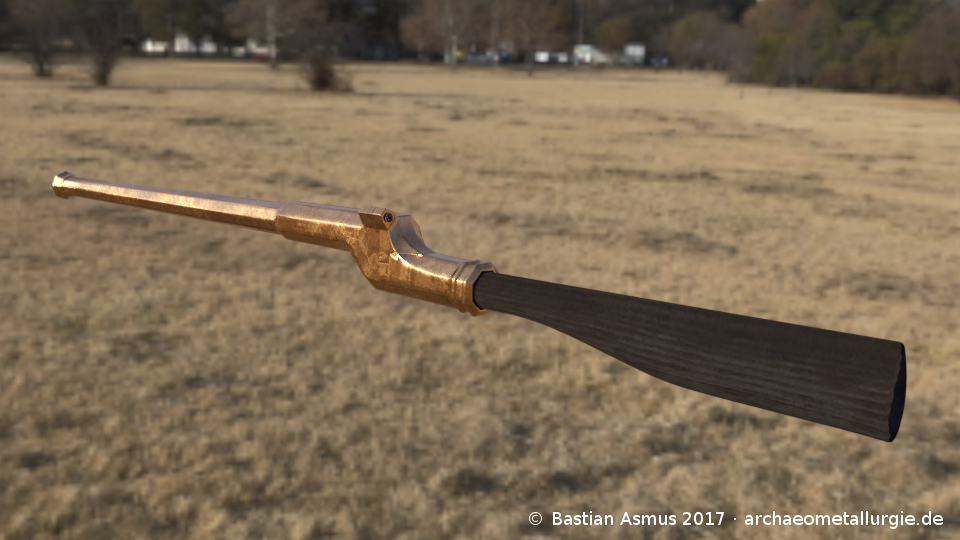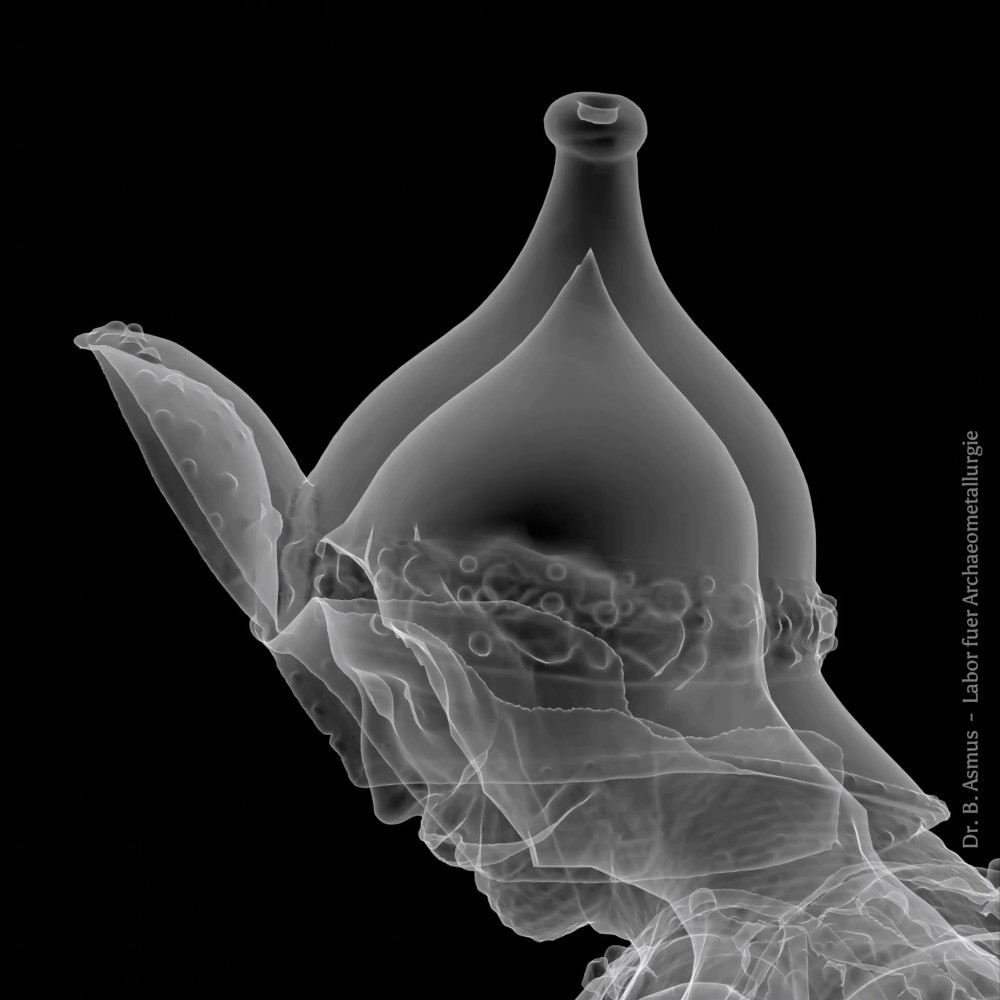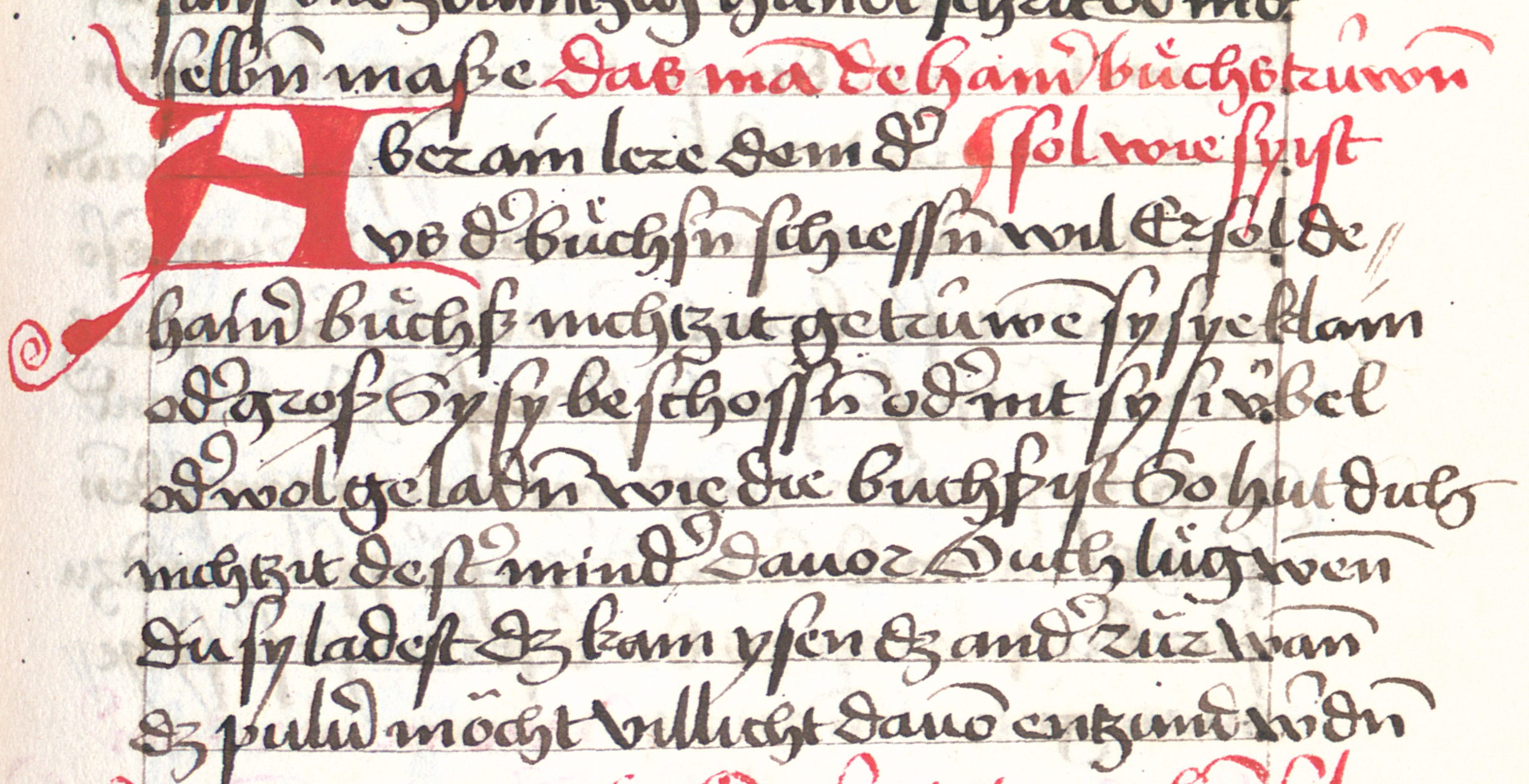
Handgonnes: A health and safety issue?
Surprisingly health and safety issues are not as new as many might suspect. At least for German speaking people they actually originate at least in medieval times. Of all things this health and safety rule is from the earliest published technical treatise in German language and deals with: Guns and how to use them. Interestingly enough there is a section that underscores the danger of these things. In my recent research on early breech loaded bronze guns and my experiments on how to make them one of the original questions is how safe are they to use. Apparently not as safe as one might hope for.
The Feuerwerkbuch, Freiburger manuscript Ms 362
Just how safe to use were they? Chapter 223 in the Feuerwerkbuch underscores the general modern perception that these where as dangerous to the wielder as to the enemy. The earliest version of the Feuerwerkbuch was transscribed to high German by Ferdinand Nibler . The complete work is available online. This very early technical treatise authored in German provides invaluable insights for the understanding of the matter of early firearm usage. And the following health and safety instruction caught my eye. It is only present in two of the surviving copies. In the Freiburger Manuscript (Freiburg Ms 362 from 1432) it reads:
In transliterated form chapter 223 as follows (Nibler 2005, 85):
Das man kainer büchß si sye groß oder si sye klain trwen sol sunnder sich daruor hüten als denne dise nächgeschribne lere dich wyset.
Aber ain lere dem der vß der büchß schiessen will er sol kainer büchß nit viel trwen si sye klain oder groß si sye Ibel oder wol geladen wie die büchß ist so hüt dich nütz dester minnder dauor ouch lçg wenn si du ladest das kain ysen das annder rüre wann das puluer möchte dauon ennzündet werden.
Transcription to high German (Nibler 2005, 40):
Dass man keiner Büchse, sie sei groß oder sie sei klein, trauen soll sondern sich vor ihr hüten, wie diese nachgeschriebene Anweisung weist.
Aber eine Belehrung für den, der aus der Büchse schießen will: Er soll einer Büchse auf keinen Fall vertrauen, sie sei klein oder groß, sie sei schlecht oder gut geladen. Wie die Büchse auch ist – hüte Dich nichtsdestoweniger davor! Sieh‘ auch zu, dass wenn Du sie ladest kein Eisen ein anderes Eisen berühre, denn das Pulver könnte davon entzündet werden!
Translation to English
That you should not trust any gonne be it small or large, but beware of it as the following instructions advise.
But a lesson to whom wants to shoot from a gonne. He shall not trust the gonne under any circumstances, be it small or large, be it badly or well loaded. In whatever state the gonne is, beware of it nonetheless. Make sure when you you load it that no iron touches another iron, as the powder may be ignited upon this.

3d reconstruction of an early breech loaded handgonne.
Bellifortis, BSB Hss Clm 30150
The second copy of the Feuerwerkbuch is preserved in the Bellifortis by Korad Kyeser . I included it here, as it is one of the few chapters that deviates from the above mentioned original.
Transliteration by the author
Das ma je kainer büchs tzündn ssol wie sy ist Aber ain lere dem der uß der büchsn schießßn wil Er sol si kainer büchs nicht zu getruwe si sye klain oder groß sy sy beschossn oder nit sy si übel oder wolgeladn wie die buchs iist so hut dich nichtzt deß mind dauor Ouch lüg wen Du sy ladest das kain ysen das ander rür wan das puluer möcht villicht dauo entzund werdn.
Transcription to high German
Daß man bloß keine Büchse zünden soll wie sie ist Aber eine Lehre dem der aus der Büchse schießen will. Er soll keiner Büchse trauen, sei sie klein oder groß. Sei sie beschossen oder nicht, sei sie schlecht oder gut geladen. Wie die Büchse ist, so hüte dich nichtsdestoweniger davor. Auch sieh zu, wenn Du sie lädst, dass kein Eisen ein anderes (Eisen) , denn das Pluver möchte vielleicht davon entzündet werden.
Translation
That you should not ignite a gonne as it is. But a lesson to whom wants to shoot from a gonne. He shall not trust a gonne, be it small or large. Be it that the gonne was fired or not, be it that it is badly or well charged. Whatever the state of the gonne, beware of the gonne nonetheless. Also make sure, when loading it, that no iron touches another (iron), as the powder might possibly ignited upon this this
Interestingly this warning is not in the printed version of the Feuerwerkbuch from 1529. As to whether this is due to higher manufacturing standards, that led to safer gonnes, or to totally different circumstances must for the moment remain open.
References
{1698736:9MQVP6FW};{1698736:GXJW2RP9}
apa
default
asc
no
2997
%7B%22status%22%3A%22success%22%2C%22updateneeded%22%3Afalse%2C%22instance%22%3A%22zotpress-6c2a0389ce593fac21f2342ab47ef2c4%22%2C%22meta%22%3A%7B%22request_last%22%3A0%2C%22request_next%22%3A0%2C%22used_cache%22%3Atrue%7D%2C%22data%22%3A%5B%7B%22key%22%3A%22GXJW2RP9%22%2C%22library%22%3A%7B%22id%22%3A1698736%7D%2C%22meta%22%3A%7B%22creatorSummary%22%3A%22Kyeser%22%2C%22parsedDate%22%3A%221430%22%2C%22numChildren%22%3A1%7D%2C%22bib%22%3A%22%3Cdiv%20class%3D%5C%22csl-bib-body%5C%22%20style%3D%5C%22line-height%3A%202%3B%20padding-left%3A%201em%3B%20text-indent%3A-1em%3B%5C%22%3E%5Cn%20%20%3Cdiv%20class%3D%5C%22csl-entry%5C%22%3EKyeser%2C%20C.%20%281430%29.%20%3Ci%3EBellifortis%20-%20BSB-Hss%26%23xA0%3B%20Clm%2030150%3C%5C%2Fi%3E.%20%3Ca%20href%3D%27http%3A%5C%2F%5C%2Fdaten.digitale-sammlungen.de%5C%2F~db%5C%2F0009%5C%2Fbsb00090291%5C%2Fimages%5C%2F%27%3Ehttp%3A%5C%2F%5C%2Fdaten.digitale-sammlungen.de%5C%2F~db%5C%2F0009%5C%2Fbsb00090291%5C%2Fimages%5C%2F%3C%5C%2Fa%3E%3C%5C%2Fdiv%3E%5Cn%3C%5C%2Fdiv%3E%22%2C%22data%22%3A%7B%22itemType%22%3A%22manuscript%22%2C%22title%22%3A%22Bellifortis%20-%20BSB-Hss%20%20Clm%2030150%22%2C%22creators%22%3A%5B%7B%22creatorType%22%3A%22author%22%2C%22firstName%22%3A%22Conradius%22%2C%22lastName%22%3A%22Kyeser%22%7D%5D%2C%22abstractNote%22%3A%22%22%2C%22manuscriptType%22%3A%22%22%2C%22date%22%3A%22um%201430%22%2C%22language%22%3A%22ger%22%2C%22url%22%3A%22http%3A%5C%2F%5C%2Fdaten.digitale-sammlungen.de%5C%2F~db%5C%2F0009%5C%2Fbsb00090291%5C%2Fimages%5C%2F%22%2C%22collections%22%3A%5B%5D%2C%22dateModified%22%3A%222023-10-07T11%3A52%3A19Z%22%7D%7D%2C%7B%22key%22%3A%229MQVP6FW%22%2C%22library%22%3A%7B%22id%22%3A1698736%7D%2C%22meta%22%3A%7B%22creatorSummary%22%3A%22Nibler%22%2C%22parsedDate%22%3A%222005%22%2C%22numChildren%22%3A0%7D%2C%22bib%22%3A%22%3Cdiv%20class%3D%5C%22csl-bib-body%5C%22%20style%3D%5C%22line-height%3A%202%3B%20padding-left%3A%201em%3B%20text-indent%3A-1em%3B%5C%22%3E%5Cn%20%20%3Cdiv%20class%3D%5C%22csl-entry%5C%22%3ENibler%2C%20F.%20%282005%29.%20%3Ci%3EDas%20Feurwerkbuch%20in%20synoptischer%20Darstellung%20zweier%20anonymer%20Originaltexte.%20Transkription%20und%20Textvergleich%20des%26%23xA0%3B%20Freiburger%20Manuskriptes%20Ms%20362%20von%201432%26%23xA0%3B%20%20und%20des%20so%20genannten%26%23xA0%3B%20%26%23xA0%3B%20Feuerwerkbuches%20von%201420%26%23xA0%3B%20%20%28gedruckt%201529%20bei%20Stainer%2C%20Augsburg%29%26%23xA0%3B%20mit%20erkl%26%23xE4%3Brenden%20Anmerkungen%20zu%20den%20Texten%3C%5C%2Fi%3E.%20%3Ca%20href%3D%27http%3A%5C%2F%5C%2Fwww.feuerwerkbuch.homepage.t-online.de%5C%2F%27%3Ehttp%3A%5C%2F%5C%2Fwww.feuerwerkbuch.homepage.t-online.de%5C%2F%3C%5C%2Fa%3E%3C%5C%2Fdiv%3E%5Cn%3C%5C%2Fdiv%3E%22%2C%22data%22%3A%7B%22itemType%22%3A%22book%22%2C%22title%22%3A%22Das%20Feurwerkbuch%20in%20synoptischer%20Darstellung%20zweier%20anonymer%20Originaltexte.%20Transkription%20und%20Textvergleich%20des%20%20Freiburger%20Manuskriptes%20Ms%20362%20von%201432%20%20%20und%20des%20so%20genannten%20%20%20%20Feuerwerkbuches%20von%201420%20%20%20%28gedruckt%201529%20bei%20Stainer%2C%20Augsburg%29%20%20mit%20erkl%5Cu00e4renden%20Anmerkungen%20zu%20den%20Texten%22%2C%22creators%22%3A%5B%7B%22creatorType%22%3A%22author%22%2C%22firstName%22%3A%22Ferdinand%22%2C%22lastName%22%3A%22Nibler%22%7D%5D%2C%22abstractNote%22%3A%22%22%2C%22date%22%3A%222005%22%2C%22language%22%3A%22%22%2C%22ISBN%22%3A%22%22%2C%22url%22%3A%22http%3A%5C%2F%5C%2Fwww.feuerwerkbuch.homepage.t-online.de%5C%2F%22%2C%22collections%22%3A%5B%5D%2C%22dateModified%22%3A%222018-01-21T11%3A44%3A23Z%22%7D%7D%5D%7D
Nibler, F. (2005).
Das Feurwerkbuch in synoptischer Darstellung zweier anonymer Originaltexte. Transkription und Textvergleich des Freiburger Manuskriptes Ms 362 von 1432 und des so genannten Feuerwerkbuches von 1420 (gedruckt 1529 bei Stainer, Augsburg) mit erklärenden Anmerkungen zu den Texten.
http://www.feuerwerkbuch.homepage.t-online.de/


